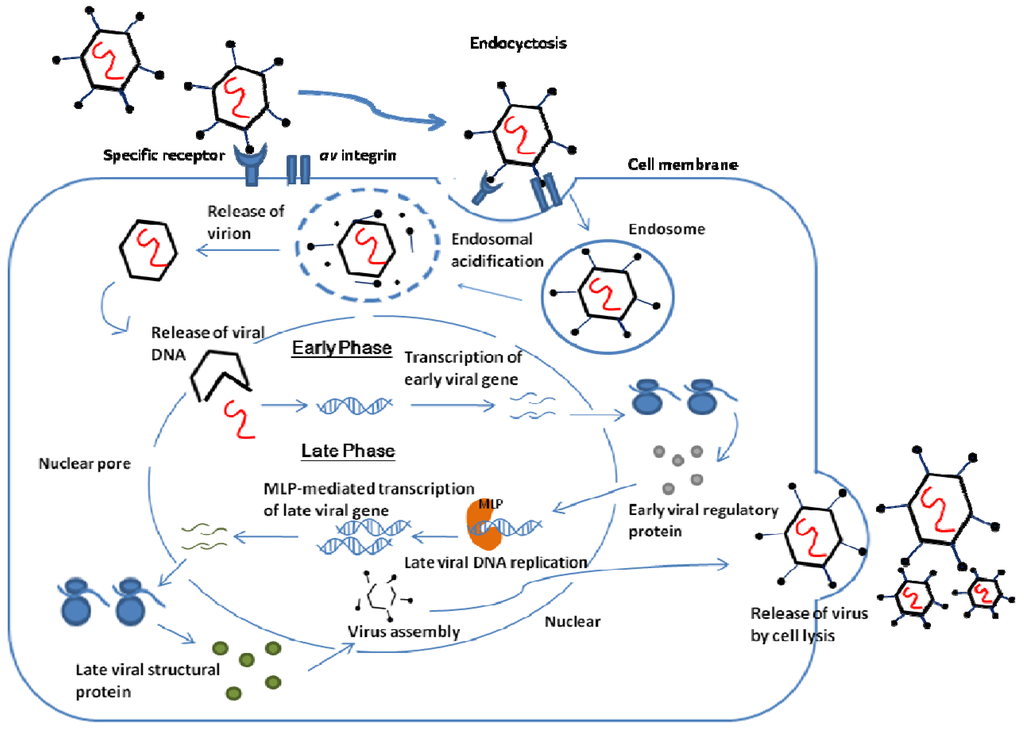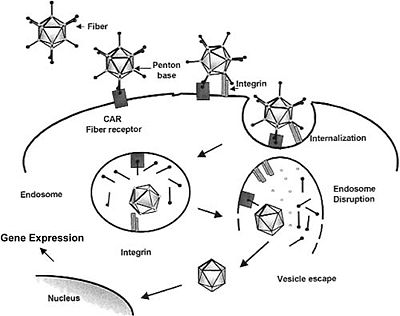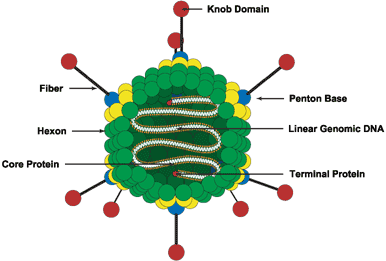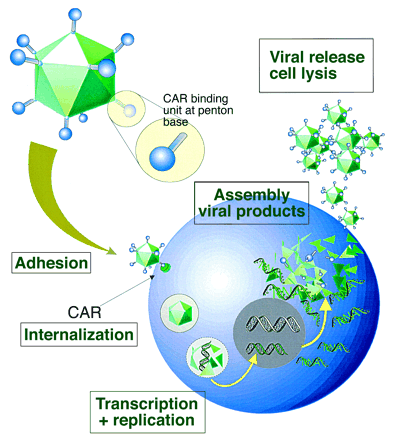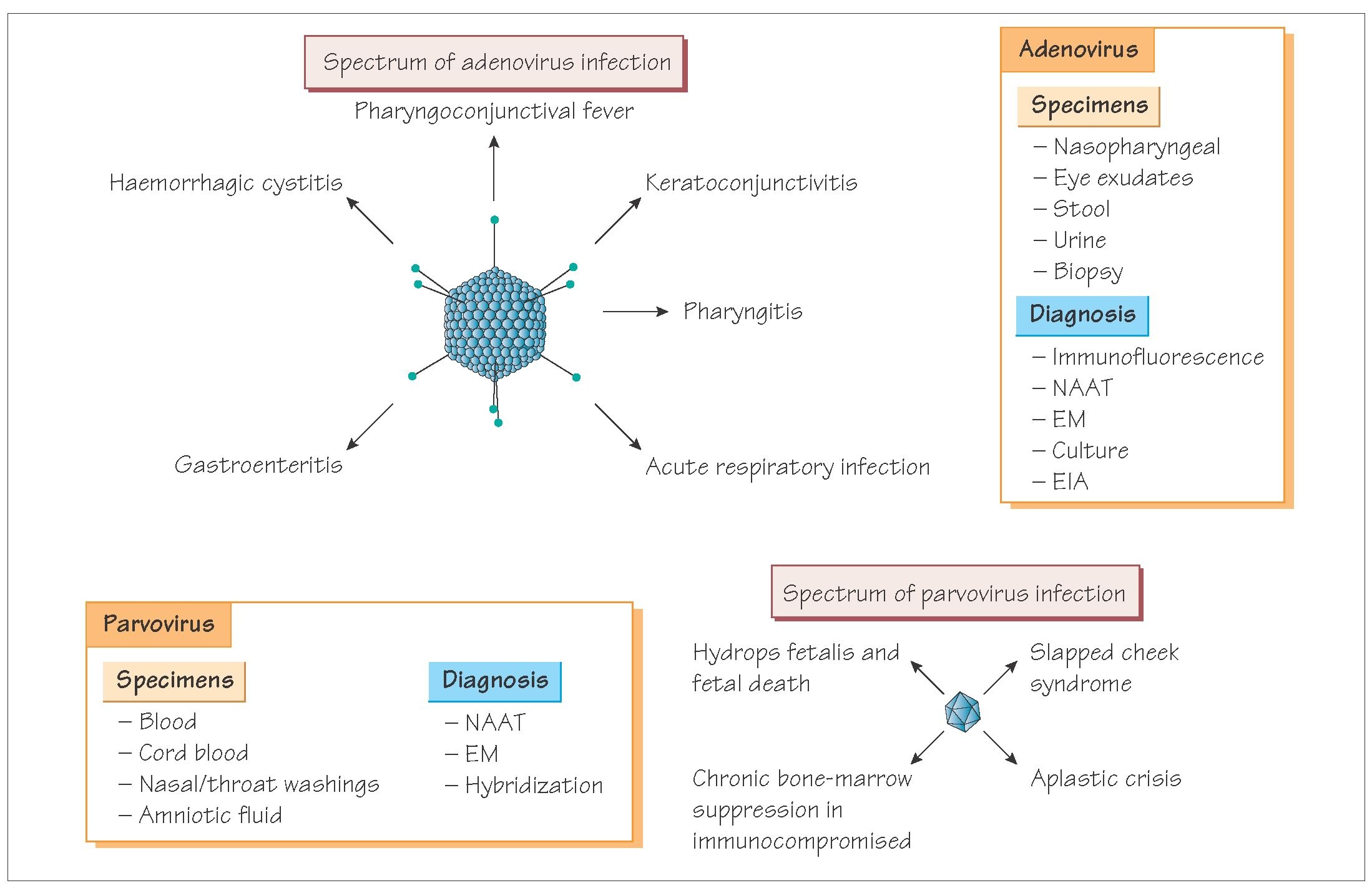Adenovirus infection
Human adenoviruses are human pathogenic viruses from the family and the genus Adenoviridae Mastadenovirus. Six of the 19 species of this genus can cause disease in humans and from human tonsils ( adenoids ) were first isolated, which also derives its name. Currently, 51 serologically distinct subtypes are found.
Features
The human pathogenic adenoviruses belong to the non-enveloped double-stranded, linear DNA viruses ( dsDNA), so they are characterized by high resistance to chemical and physical agents and tolerate extreme pH values and alcoholic disinfectant. Ten-minute heating at 56 ° C for inactivating the other hand, completely. Your stable icosahedral capsid and the absence of a delicate shell leads to a long-lasting infectivity outside the host body. Adenoviruses are approximately 70-90 nm in diameter in size, as they possess a genome of double-stranded linear DNA.
- Virion of adenovirus
- Structure of the adenoviruses
- Schematic drawing of an adenovirus
- Genome of adenoviruses
Clinic
Adenoviruses primarily cause respiratory diseases. Depending on the serotype, however, a number of other diseases can be caused, for example, gastroenteritis, epidemic keratoconjunctivitis, cystitis, rhinitis, pharyngitis or diarrhea. Symptoms of respiratory illness caused by adenovirus range from the common cold, acute bronchitis to pneumonia. In patients with compromised immune systems, there is a particular vulnerability to serious complications of adenovirus infection, such as ARDS or Acute Respiratory Distress Syndrome. Also it is assumed that there is a correlation between the virus type Ad-36 and obesity in humans.
Epidemiology
Although the epidemiological characteristics of the adenoviruses vary from type to type, but all are spread by direct contact, fecal- oral, and occasionally passed through water transfer. Some types cause persistent, asymptomatic infections of the ear and adenoids or gastro- intestinal tract of the host; a propagation can occur over months or years. Few adenoviruses (eg, serotypes 1, 2, 5 and 6) are endemic proven in some areas of the world; the infection occurs here is usually in childhood. Other species cause occasional outbreaks in otherwise sporadic infections. For example, the epidemic keratoconjunctivitis is triggered by the serotypes 8, 19 and 37. Epidemic of febrile illness with conjunctivitis are often associated with adenoviruses and generally occur in the environment of inadequate chlorinated swimming pools and small lakes. Be gastroenteritis, especially in children caused by the serotypes 40 and 41. In some serotypes, the clinical spectrum of infection-associated diseases varies depending on the entry point. For example, is accompanied by an infection with adenovirus 7 by inhalation with serious diseases of the lower respiratory tract, whereas oral transmission of the virus causes no or only a mild infection.
Diagnosis
Antigen detection, PCR assay, virus isolation, electron microscopy and serology are used for the detection of adenovirus infections. The type determination is usually made by Hämagglutinationshemmungsreaktion or neutralization with type-specific antisera. Since adenovirus can be excreted over a longer period, means of detection of the virus is not necessarily evidence of disease.
Therapy
Most infections are mild and require no treatment or symptomatic treatment. But even with serious diseases caused by adenovirus infection is the lack of treatment of virus-specific therapy in a treatment of the symptoms and complications of the infection.
Prevention
For serotypes 4 and 7 vaccines have been developed that are available but only for the prevention of severe respiratory infections in recruits of the U.S. armed forces. For the effective restriction of the propagation of adenovirus -associated diseases, such as epidemic keratoconjunctivitis, which necessitated the temporary closure of several Bundeswehr bases in 2004, a careful infection control is necessary.
Late complications
Discussed are various medical conditions that can be set as late sequelae of adenovirus infection, such as persistent bronchiolitis, joint pain, the dilated cardiomyopathy or sudden hearing loss. In many cases, has so far been assumed that adenoviruses were considered as a trigger for type 1 diabetes, but 2013 turned out to be relatively unlikely by the results of the international study TEDDY (The Environmental Determinants of Diabetes in the Young ).
Therapeutic use of adenoviruses in medicine
Adenoviruses are increasingly finding use in medical therapy, for example as Dystrophinträger in gene therapy of Duchenne muscular dystrophy, a genetically engineered vaccine for example against Ebola virus infections or in cancer therapy to inhibit tumor growth.
Compulsory registration
The reporting requirement of adenoviruses only Conjunctival regulated in Germany by § 7 iFSG.



